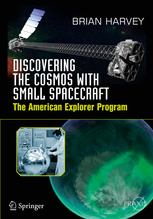Description
Discovering the Cosmos with Small Spacecraft, 1st ed. 2018
The American Explorer Program
Space Exploration Series
Author: Harvey Brian
Language:
Subjects for Discovering the Cosmos with Small Spacecraft:
284 p. · 16.8x24 cm · Paperback
Description
/li>Contents
/li>Biography
/li>Comment
/li>
Presents the history of the Explorer program of small American scientific satellites
Outlines Explorer's pioneering studies in a number of scientific disciplines, narrating the story of how these satellites improved our knowledge of near-Earth space, the interrelationship between the Sun and Earth, and astronomy at wavelengths impossible to study from the surface of Earth
Brings together space science, spacecraft design, the personalities involved, the rockets (Juno, Scout, Delta etc), the infrastructure, the management, and the dissemination process in one comprehensively informative package of Explorer program history
Compares and contrasts the Explorer program with other contemporaneous programs of scientific satellites

